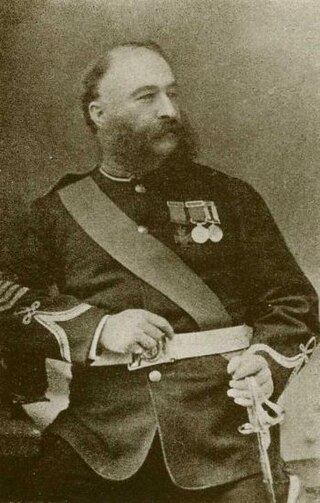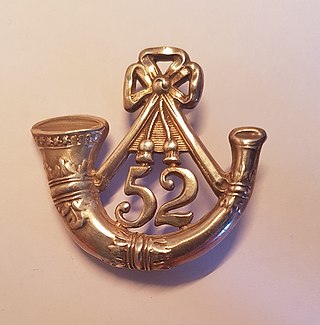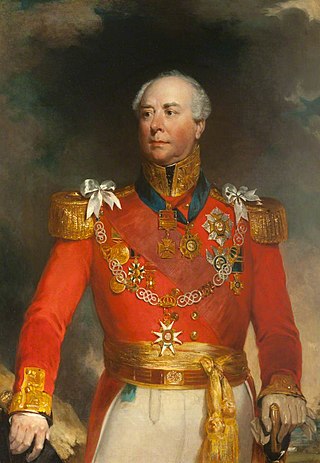
The Coldstream Guards is the oldest continuously serving regular regiment in the British Army. As part of the Household Division, one of its principal roles is the protection of the monarchy; due to this, it often participates in state ceremonial occasions. The Regiment has consistently provided formations on deployments around the world and has fought in the majority of the major conflicts in which the British Army has been engaged.

At the Battle of Roliça, the first battle fought by the British army during the Peninsular War, an Anglo-Portuguese army under Sir Arthur Wellesley defeated an outnumbered Imperial French division under General of Division Henri François Delaborde, near the village of Roliça in Portugal. The French retired in good order.

Thomas Beach VC was a British Army soldier and a Scottish recipient of the Victoria Cross, the highest award for gallantry in the face of the enemy that can be awarded to British and Commonwealth forces. Beach suffered from severe alcoholism later in life. He died due to his alcoholism at the age of 40.

William Bradshaw VC, born in Thurles, County Tipperary, was an Irish recipient of the Victoria Cross, the highest and most prestigious award for valour in the face of the enemy that can be awarded to British and Commonwealth forces.

Campbell Mellis Douglas, was a Canadian recipient of the Victoria Cross, the highest and most prestigious award for gallantry in the face of the enemy that can be awarded to British and Commonwealth forces. The awarding of the VC to Douglas was one of the few instances of the VC being awarded for actions taken not in the face of the enemy.

Cornelius Coughlan VC was an Irish recipient of the Victoria Cross, the highest and most prestigious award for gallantry in the face of the enemy that can be awarded to British and Commonwealth forces.

Matthew Hughes VC was an English recipient of the Victoria Cross, the highest and most prestigious award for gallantry in the face of the enemy that can be awarded to British and Commonwealth forces.

John Lucas VC was a British Army soldier and a recipient of the Victoria Cross, the highest award for gallantry in the face of the enemy that can be awarded to British and Commonwealth forces. He was the first member of the 40th Foot to be awarded the VC.

Lieutenant Colonel Frederick Cockayne Elton VC was an English recipient of the Victoria Cross, the highest and most prestigious award for gallantry in the face of the enemy that can be awarded to British and Commonwealth forces.

John Paton VC was a Scottish recipient of the Victoria Cross, the highest and most prestigious award for gallantry in the face of the enemy that can be awarded to British and Commonwealth forces.
Herbert Taylor Reade, was a Canadian born recipient of the Victoria Cross, the highest and most prestigious British honour. The award was for gallantry in the face of the enemy.

Brigadier-General John Jacob CB was an officer of the British East India Company who served in colonial India for the major portion of his career. He is known for the cavalry regiment called 36th Jacob's Horse, and for founding the town of Jacobabad, in Sind province of British India, where he planned and supervised the transformation of thousands of acres of desert into arable land over the course of twenty years. The scale of progress and prosperity his works brought to the region can be appreciated by comparing those regions' relative prosperity compared to areas which were not under his administrative jurisdiction.
The 41st (Welch) Regiment of Foot was an infantry regiment of the British Army, raised in 1719. Under the Childers Reforms it amalgamated with the 69th Regiment of Foot to form the Welch Regiment in 1881.
The 101st Regiment of Foot (Royal Bengal Fusiliers) was an infantry regiment of the East India Company and British Army that existed from 1652 to 1881. The regiment was raised in India in 1652 by the East India Company as the company's first non-native infantry regiment. Over the following two centuries, the regiment was involved in nearly all of the East India Company's conflicts which consolidated British rule over India. The Royal Bengal Fusiliers was transferred to the command of the British Army in 1862 following the Indian Mutiny of 1857 and the end of Company rule in India. Under the Childers Reforms it amalgamated with the 104th Regiment of Foot (Bengal Fusiliers) to form the Royal Munster Fusiliers in 1881.

The 52nd (Oxfordshire) Regiment of Foot was a light infantry regiment of the British Army throughout much of the 18th and 19th centuries. The regiment first saw active service during the American War of Independence, and were posted to India during the Anglo-Mysore Wars. During the Napoleonic Wars, the 52nd were part of the Light Division, and were present at most major battles of the Peninsula campaign, becoming one of the most celebrated regiments, described by Sir William Napier as "a regiment never surpassed in arms since arms were first borne by men". They had the largest British battalion at Waterloo, 1815, where they formed part of the final charge against Napoleon's Imperial Guard. They were also involved in various campaigns in India.

The 94th Regiment of Foot was a British Army line infantry regiment, raised as the Scotch Brigade in October 1794. It was renumbered as the 94th Regiment of Foot in December 1802 and disbanded in December 1818. The regiment was reformed in December 1823 and served until 1881 when it amalgamated with the 88th Regiment of Foot to form the Connaught Rangers.

General Sir Archibald Campbell, 1st Baronet was a Scottish soldier who served as an officer in the British Army. From 1824 to 1826, Gen. Campbell commanded the British forces in the First Anglo-Burmese War, the longest and most expensive war in British Indian history, that gave the British control of Assam, Manipur, Cachar, Jaintia, Arakan and Tenasserim. He became known as the "Hero of Ava". From 1831 to 1837, he was the administrator of the colony of New Brunswick, Canada. The Canadian city of Campbellton in the province of New Brunswick was named in his honour.

John James Snodgrass, was a British military officer, aide-de-camp and son-in-law to Sir Archibald Campbell, 1st Baronet and author. He fought in the Battle of Waterloo. The last seven years of his life were spent in Halifax, Nova Scotia where he died and is buried in the Old Burying Ground.
General Sir William Henry Sewell, was a senior officer in the British Army.

General Sir James Archibald Hope, was a senior officer in the British Army.















